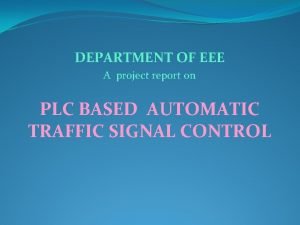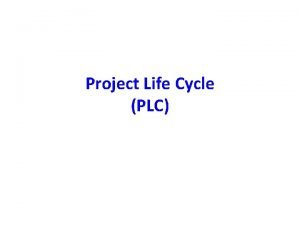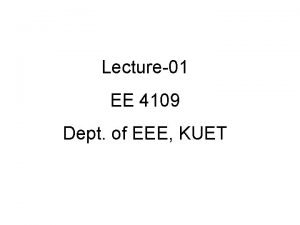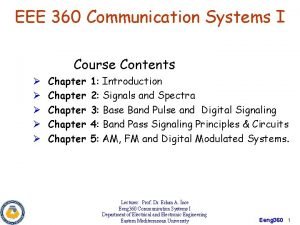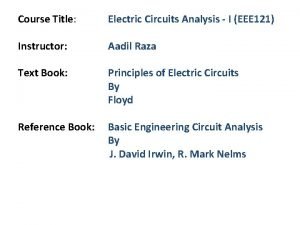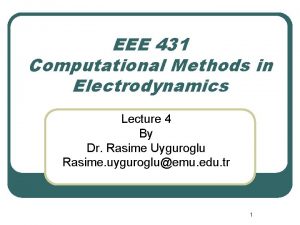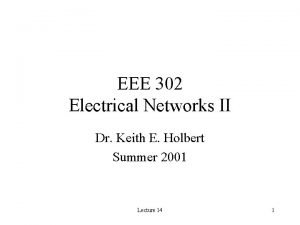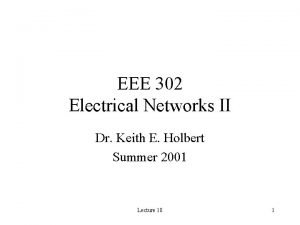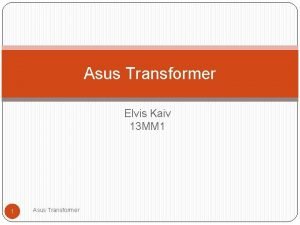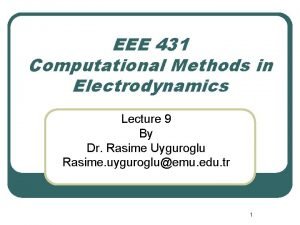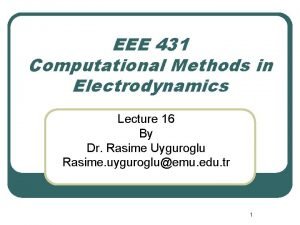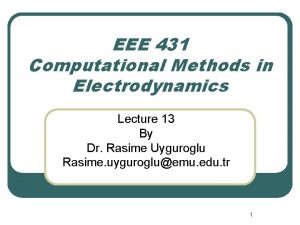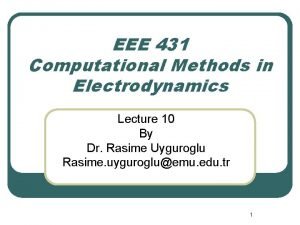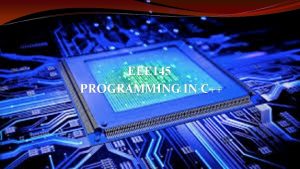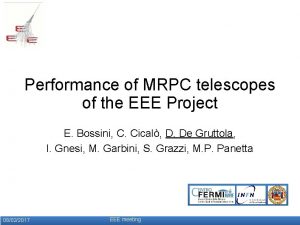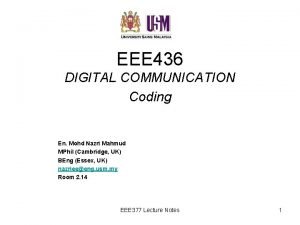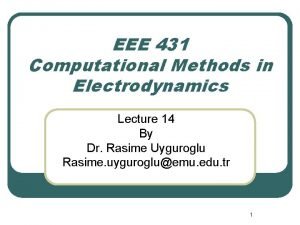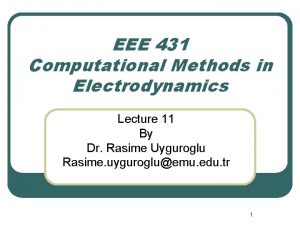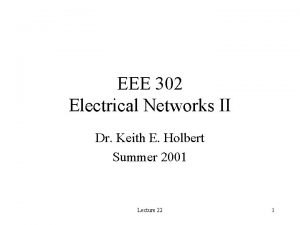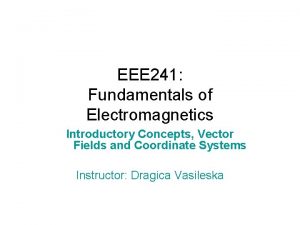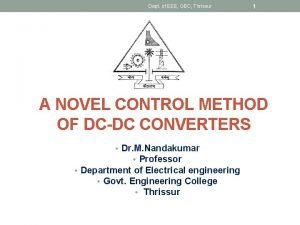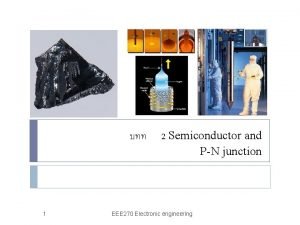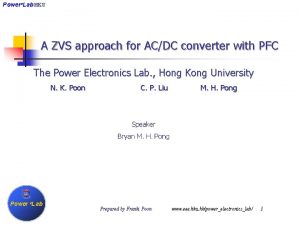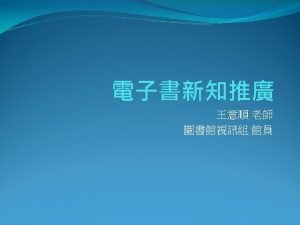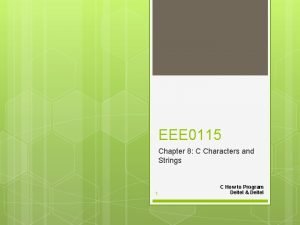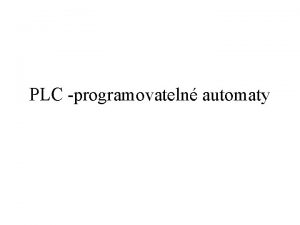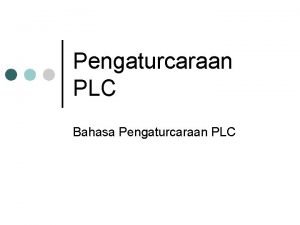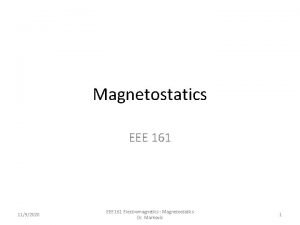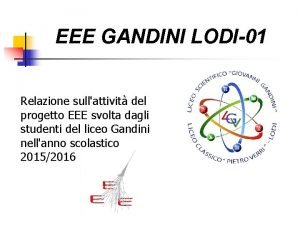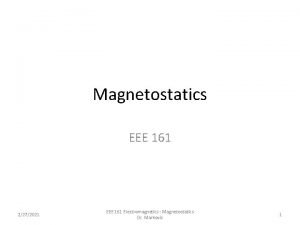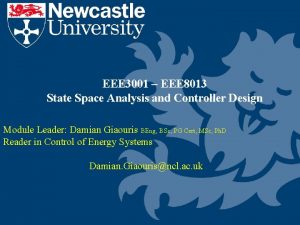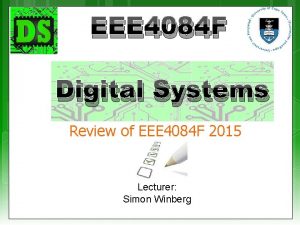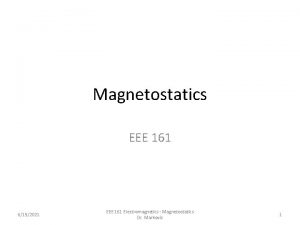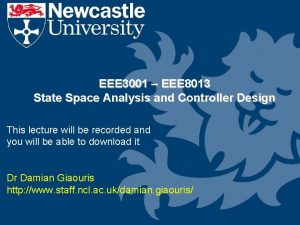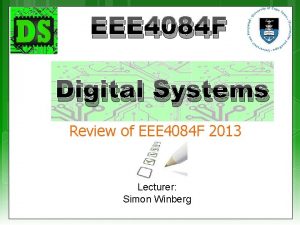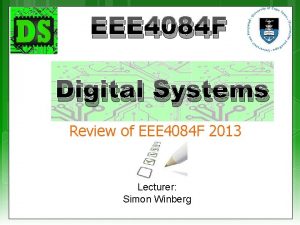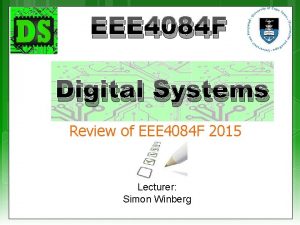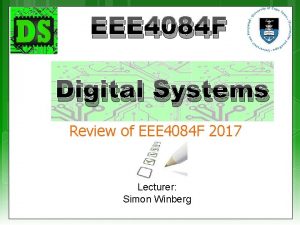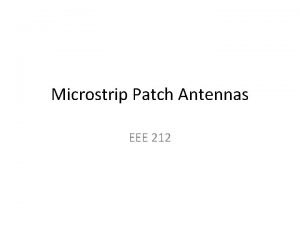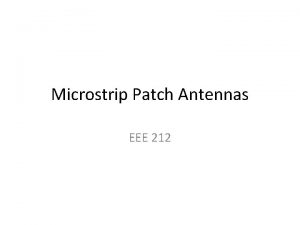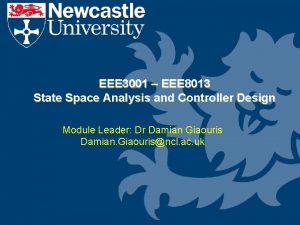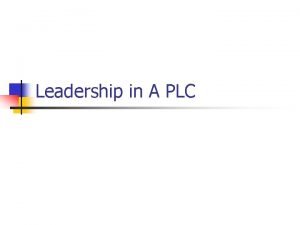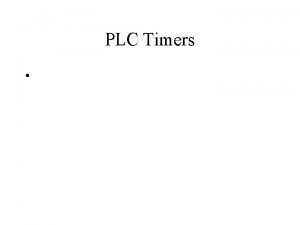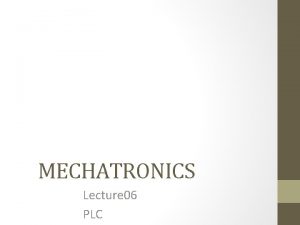DEPARTMENT OF EEE A project report on PLC





























- Slides: 29

DEPARTMENT OF EEE A project report on PLC BASED AUTOMATIC TRAFFIC SIGNAL CONTROL

INTRODUCTION AUTOMATION v Automation or automatic control, is the use of various control systems for operating equipment such as machinery, processes in factories, boilers and heat treating ovens, switching on telephone networks, aircraft , reduced human intervention v The biggest benefit of automation is that it saves labor; however, it is also used to save energy and materials and to improve quality, accuracy and precision v Automation has been achieved by various means including mechanical, hydraulic, pneumatic, electrical, electronic devices and computers, usually in combination

Advantages of automation v Reduction in production time v Increase in accuracy and repeatability v Less human error v Less employee cost v increased safety v Higher volume production

INTRODUCTION OF PLC v Programmable logic controllers (PLCs) have been an integral part of factory automation and industrial process control for decades v PLCs control a wide array of applications from simple lighting functions to environmental systems to chemical processing plants. v These systems perform many functions, providing a variety of analog and digital input and output interfaces; signal processing; data conversion; and various communication protocols v All of the PLC's components and functions are centered around the controller, which is programmed for a specific task

OPERATION OF PLC Ø The PLC is running and the scanning process, Includes the following four steps v CHECK SELF TEST - Testing of its own hardware and software for these PLC faults. v CHECK INPUT STATUS - If there are no problems in plc. After the PLC takes a look at each input to determine whether it is on or off condition. v EXECUTE PROGRAM -Next the PLC executes a program by one instruction at a time Ø If the first input is on then it should turn on the first output. Since it already knows then it will be able to decide whether the first output Ø should be turned on based on the state of the first input

Hystorical background v The hydrodynamic division of the general motors corporation specified the design criteria for the first programmable controller in 1968 Ø Their primary goal of PLC: § To eliminate the high costs associated with inflexible, relay-controlled systems § The control system needed the capability to pass data collection to a central system. § The system had to be reusable § The method used to program the controller had to be simple, so that it could be easily understood by plant personnel.

TYPES OF PLC 4 Ø Allen Bradley PLCs (AB) Ø ABB PLCs (Asia Brown Bovary) Ø Siemens PLCs Ø Omron PLCs Ø Mitsubishi Ø Hitachi PLCs Ø Delta PLCs Ø General Electric (GE) PLCs Ø Honeywell PLCs Ø Modicum PLCs Ø Schneider Electric PLCs Ø Bosch PLCs

PLC INSTRUCTIONS v Normal open v normal close v out put v Not function v AND function v OR function v SET-coil v RE-SET coil v positive edge v negative edge v T ON(ON –DELAY TIMER) v T OF (OFF-DELAY TIMER)

ADVANTAGES OF PLC Very fast. Easy to change logic i. e. flexibility. Reliable due to absence of moving parts. Low power consumption. Easy maintenance due to modular assembly. Facilities in fault finding and diagnostic. Capable of handling of very complicated logic operations. Good documentation facilities Easy to couple with the process computers. v Analog signal handling and close loop control programming. Counter, timer and comparator can be programmed. v v v v v Ease operator interface due to colourographic and advisory system introduction.

DIS ADVANTAGES OF PLC v A lot of hard wiring is required for connection of input and output devices. v Since PLC is a semiconductor device, it can’t be operated over a level of temperature where it can’t sustain it. v Debugging with PLCs may become tedious as finding the fault is not very easy. v Initial cost of PLC is high

APPLICATIONS OF PLC v Application of PLC in Glass Industry Ø From the year 1980 the Programmable-logic controllers are in use in the glass industry, and they are assembled bit by bit Ø . PLCs are used mainly in every procedure and workshop for controlling the material ratio, processing of flat glasses, etc Ø With the development of PLC and increasing demand in the real world. Ø the control mode of the programmable-logic controller

v Applications of PLC in cement industry v The PLC is used for controlling the ball milling, shaft kiln and Kiln of coal. v Now a days a DCS with bus technology is used in the production and management industry v By using this existing DCS control system, the PLC is in user mode of SCADA

DELTA PLC v The delta name indicates it is one of the manufacturing company name v This delta PLC is very economical and costless compared with other PLC’S and its output is also very accurate and fast response v 1 WPL SOFT 2. 41 DELTA PLC SOFTWARE

F 1 - NO F 2 - NC F 3 - RISING EDGE TRIGGER SWITCH F 4 - FALLING EDGE TRIGGER SWITCH F 5 - STEP POINT F 6 - APPLICATION INSTRUCTION PN - POSITIVE TO NEGATIVE MODE CTRL+F 9 - READ FROM PLC C+D - DELETE HORIZONTAL LINE F 7 - OUTPUT COIL F 8 - HORIZONTAL LINE F 9 - VERTICAL LINE F 11 - INVERSE LOGIC F 12 - COMPARISON CTRL +F 12 - STOP CTRL +F 4 - ONLINE F 8 - WRITE TO PLC NP - NEGATIVE TO POSITIVE 7. Choose ladder diagram mode to draw your ladder diagrams in PLC, then a window named LADDER DIAGRAM MODE APPEARS as shown below

Communication Cable: RS-232 VIEW OF DELTA PLC

PIN DIAGRAM OF DVP 60 ES 2 INPUTS AND OUTPUTS Our plc model is DELTA DVP-60 ES 2. It consists of 36 inputs and 24 outputs. All inputs and outputs are in digital (binary format)type. It represent to. X 0, X 1, X 2, X 3, X 4, X 5, X 6, X 7, X 8, X 9, X 10, X 11, X 12, X 13, X 14, X 15, X 16, X 17, X 20, X 21, X 22, X 23, X 24, X 25, X 26, X 27, X 30, X 31, X 32, X 33, X 34, X 35, X 36, X 37, X 40, X 41, X 42, X 43 are inputs. And out puts are Y 0, Y 1, Y 2, Y 3, Y 4, Y 5, Y 6, Y 7, Y 10, Y 11, Y 12, Y 13, Y 14, Y 15, Y 16, Y 17, Y 20, Y 21, Y 22, Y 23, Y 24, Y 25 , Y 26, Y 27. C 0, C 1, C 2, C 3, C 4, C 5 are common pins. COM 1, COM 2, COM 3 are communication ports. RUN AND STOP BUTTON to run and stop the PLC.

FEATURES � ES 2 series is a small PLC for basic sequential control. It is economical, highly efficient and functional. SPECIFICATIONS �MPU points: 16 / 20 / 24 / 32 / 40 / 60 �Program capacity: 16 k steps �Built-in with 3 COM ports: 1 RS-232 port and 2 RS 485 ports, all are able to operate independently (Master/Slave) �Max. I/O points: 256 input points + 16 output points, or 256 output points + 16 input points

APPLICATIONS : v Application in emerging industry: Exclusive instructions and function blocks designed for PV solar tracker v. Handy instructions for frequency inverter: For controlling the forward running, reverse running, RUN and STOP of Delta’s AC motor drives v Password protection: Password for subroutine, user ID, restriction on trial times Highly efficient instruction execution HVAC, molding injection machine, big storage management, packaging machine, precise

PLC BASED AUTOMATIC TRAFFIC SIGNAL CONTROL v A traffic light or traffic signal is a signaling device positioned at a road intersection, pedestrian crossing, or other location in order to indicate when it is safe to drive, ride, or walk using a n universal color code v A traffic light, traffic signal, or stop light is a signaling device positioned at a road intersection, pedestrian crossing, or other location in order to indicate when it is safe to drive, ride, or walk using a universal color code v However for the pedestrians, there have only two lights, a red light and a green light that mean go and stop respectively v The traffic lights have given many benefits to all road users. Besides reducing the number of accidents, it made the traffic flow smoothly and possibly could save people time.

EVOLUTION OF TRAFFIC LIGHT �POLICE CONTROLLED DEVICE �TRAFFIC TOWER � FIRST ELECTRIC SIGNAL � MODERN AGE OF TRAFFIC LIGHT � LIGHT EMITTED DIODES (LEDS) TRAFFIC LIGHT � PLC CONTROLLER

EXPERIMENTAL KIT DIAGRAM

PANNEL WIRING DIAGRAM

WORKING v The ‘PLC’ program is designed to associate traffic light system working in parallel with the barrier cut, consists of four stages: Now press push button switch and process goes on v At First stage, in programmed 3 POLEs in all RED’S are ON condition. All GREEN’S are OFF condition in particular time, the timer is ON v The second stage, when the time is completed only POLE-1 GREEN is ON condition at a time POLE-1 RED is OFF condition remaining POLE-2 and POLE-3 RED’S are ON condition and GREEN’S are OFF condition in particular time v The third stage, when the time is completed only POLE-2 GREEN is ON condition at a time POLE-2 RED is OFF condition, remaining POLE-1 and POLE-3 RED’S are ON condition and GREEN’S are OFF condition in particular time. v The fourth stage, when the time is completed only POLE-3 GREEN is ON condition at a time POLE-3 RED is OFF condition, remaining POLE-1 and POLE-2 RED’S are ON condition and GREEN’S are OFF condition in particular time.

v This process (step-2 and step-3 and step-4) conditions are continuously repeated. v When the push button is OFF the process will be STOP

SIGNAL LIGHTS v MERITS 1. Provide for orderly movement of traffic. 2. Increase traffic-handling capacity of an intersection. 3. Reduce frequency and severity of certain types of crashes, especially right-angle Collisions. 4. Provide for continuous movement of traffic at a definite speed along a given route. 5. Interrupt heavy traffic at intervals to permit other vehicles or pedestrians to cross

v DEMERITS � 1. Excessive delay. � 2. Increased traffic congestion, air pollution and gasoline consumption. � 3. Disobedience of signals. � 4. Increased use of less-adequate streets to avoid traffic signals. � 5. Increased frequency of crashes, especially rear-end collisions

FUTURE SCOPE

The project is presented by D. Sritulasi V. Brahmaiah M. Ramakrishna G. Ramakrishna D. Indira Under the guidence of J. Venkatesh sir.

TH K N A U O Y
 Delta dvp60es2 wiring diagram
Delta dvp60es2 wiring diagram Jenis plc
Jenis plc Kuet eee
Kuet eee Analog communication
Analog communication Ankara university
Ankara university Eee 121
Eee 121 Eee 431
Eee 431 Eee 302
Eee 302 Eee 302
Eee 302 Tahvel.edu.eee
Tahvel.edu.eee Eee 431
Eee 431 Eee 431
Eee 431 Eee 431
Eee 431 Eee 431
Eee 431 Eee 145
Eee 145 Lecc
Lecc Lempel-ziv coding in digital communication
Lempel-ziv coding in digital communication Eee 431
Eee 431 Eee 431
Eee 431 3 phase short circuit
3 phase short circuit Quality factor of rlc circuit
Quality factor of rlc circuit Dot product
Dot product Eee
Eee ëëë
ëëë Eee
Eee Android asus eee pc
Android asus eee pc Powere
Powere Flash pdf
Flash pdf Schematic arrangement of diesel power plant
Schematic arrangement of diesel power plant String conversion
String conversion
